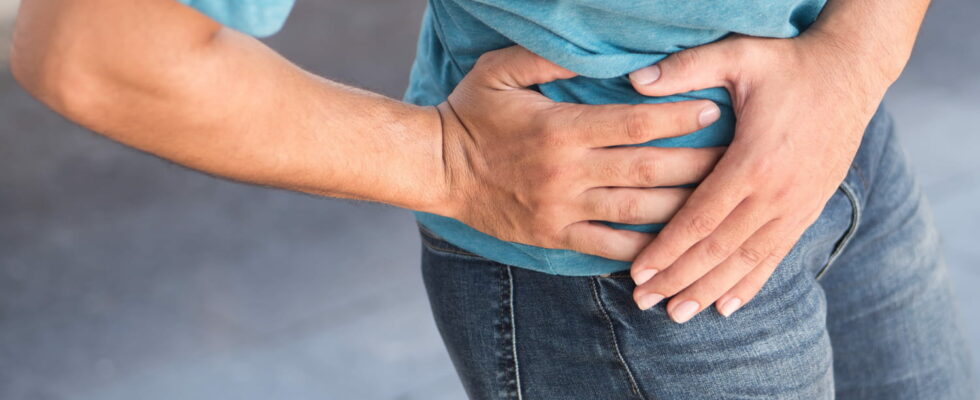Hip osteoarthritis can occur earlier than you think, sometimes as early as age 45. Plan.
After knee osteoarthritis, it is the most common location of osteoarthritis. Coxarthrosis is the medical term for osteoarthritis of the hip, at the level of the so-called coxofemoral joint, that is to say between the pelvis and the femur. Osteoarthritis is a degenerative cartilage disease responsible for a reduction in the joint surface located between two bones. Normal aging of cartilage over the course of life cannot cause osteoarthritis on its own. As soon as pain and discomfort appear in the hip, you should first consult your doctor. Thanks to the clinical examination and certain additional tests such as a hip x-ray, he can confirm the diagnosis of coxarthrosis.
What are the symptoms of hip osteoarthritis?
Osteoarthritis of the hip often causes no symptoms for many years or only mild pain, but it becomes disabling at a more advanced stage of its development. The pain is localized in the groin or buttock and can radiate down the front of the thigh, sometimes even as far as the knee. They are usually triggered by movements (walking, going up or down stairs for example) and calmed by resting the hip. A feeling of painful stiffness in the morning upon waking up, diminishing within a few minutes, may appear. Coxarthrosis most often leads to lameness. The progression of hip osteoarthritis occurs slowly over 15 to 20 years. The pain in the groin, buttocks, or thigh is increasingly violent, making walking difficult.
What are the causes of osteoarthritis in the hip?
► age: Osteoarthritis of the hip mainly occurs with age and aging. This is called primary or primary coxarthrosis. It affects 10% of people aged 65 to 75, especially women. It has no detectable cause, and appears on a hip without any malformation.
► sex: it is not really a “cause” but a risk factor. Women are more affected by hip osteoarthritis.
► a disease: hip osteoarthritis can also be secondary to another disease. It occurs earlier (around age 45), is more serious and progresses more quickly than primary coxarthrosis. It is mainly associated with morphological abnormalities of the hip. Hip dysplasia, the cause of certain malformations of the pelvic bones, or a malformation of the end of the femur, can cause osteoarthritis of the hip. Malformations of the pelvic bones can trigger congenital hip dislocation, most of the time detected in early childhood, and sometimes only in adulthood.
► certain professions: such as farmers or construction workers cause premature wear of these joints.
► certain sports practiced since childhood such as football, rugby, judo and dance promote the occurrence of hip osteoarthritis. When the diagnosis of osteoarthritis is confirmed, it is still possible to practice less violent sports such as swimming, cycling or jogging (avoiding running on too hard surfaces).
A hip x-ray to confirm the diagnosis
The doctor’s clinical examination already allows us to consider the diagnosis: standing, lying down and walking he checks for the presence of painful points in the hip joint, the reduction in the range of movements of the diseased hip in relation to to the other side and muscle trophicity. The examination also makes it possible to look for lameness while walking. Sometimes the diagnosis is more difficult due to atypical pain in the knee or thigh suggesting neuralgia. Confirmation will be provided by an x-ray of the pelvis and hip. Hip radiography remains the main examination to confirm the diagnosis of osteoarthritis and to clarify its origin, primary or secondary.
Treatments to relieve hip osteoarthritis
When the diagnosis is made with certainty, the treatment aims above all to reduce the pain and relieve the patient. It is also about reducing the risk of painful movements. But there is no question of stopping moving, on the contrary. It is through daily movement that you will prevent the onset of hip osteoarthritis, but also limit its worsening.
► Analgesic medications or nonsteroidal anti-inflammatories during periods of painful flare-ups (also called “crisis”) are useful. They can be prescribed by the attending physician.
► Rehabilitation with a physiotherapist allows, through massage and flexibility techniques, to maintain or improve the range of movements, and to strengthen the musculature and joint stability of the hip.
► Corticosteroid infiltrations in the joint, most often in addition to oral drug treatments when they are not sufficiently effective.
► Surgical treatment of a malformation can slow or prevent progression to osteoarthritis. In the absence of pain control and in cases of advanced osteoarthritis, we can also consider an operation with the installation of a total hip prosthesis.
► In certain cases, walking assistance using shoes, insoles, orthotics or canes may be offered.
In addition to medical and surgical care, unotWeight loss in obese or overweight people helps limit the worsening of osteoarthritis.
